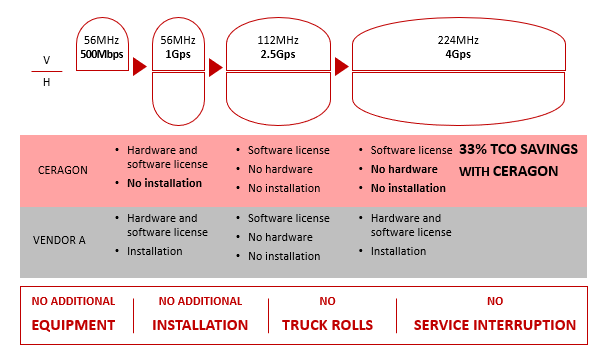This famous quote of former US president Dwight D. Eisenhower reminds us of the importance of preparing for the unexpected. This is all too relevant for 5G rollout. The plan is to bring 5G services to as many customers as quickly as possible. However, the road to full 5G rollout is paved with many uncertainties for which planning is required. Exactly how much capacity will be needed? How many subscribers at which locations will have to be served? When will each region need what capacity? What awaits us in one year or five years?
To ensure sustainable service provision and optimal customer experience, operators must look at the potential upgradability and flexibility of any solution they are considering for their 5G networks. Instead of looking at the current capacity provision and costs, operators must look at the expected upgrade path and the total cost of ownership (TCO) over time for any solution under consideration. The goal for 5G network solutions is to find the optimal low-cost upgrade path granting maximum flexibility. Only these flexible solutions will enable operators to plan for all likely scenarios, thereby ensuring optimal customer experience for their subscribers at minimum TCO.
Wireless 5G transport networks can be designed to be flexible and upgradable using leading-edge technologies. Examples are remote second-core activation, where operators can upgrade capacity at the click of a button as and when needed. This avoids the need for truck rolls or additional equipment and prevents link downtime. In other words, operators can upgrade capacity with no additional CAPEX or OPEX, and without compromising the user experience.
Multivendor and multiband capabilities also increase flexibility and allow for capacity upgrades. With multivendor capabilities, existing footprint can be utilized, avoiding unnecessary investment. Telcos avoid vendor lock-in, so that in the future they can freely choose solutions from whomever they want.
Multiband, while allowing the use of existing equipment, optimizes TCO in another way. Where relevant, higher-cost frequencies can be avoided, and low-cost or even free spectrum can be utilized. Open RAN network infrastructures yield benefits of flexibility and avoidance of vendor lock-in. Wideband capabilities are also a great enabler for flexibility and upgradability. As higher capacity is needed, more bandwidth can be used without the need to purchase and install further equipment. Again, this saves money while reducing time to market (TTM) and time to revenues.
Let’s look at Ceragon’s IP-50C as an example showing the importance of comparing upgrade paths across different vendors. When comparing upgrade paths the true picture surfaces, letting operators really understand what awaits them with each solution in terms of performance, service provision and TCO over time.
The IP-50C not only offers the most flexible and fast upgrade, but also allows for the highest CAPEX and OPEX savings compared to alternative vendors. The upgrade from 500Mbps requires only a software license, where competing solutions require installation of additional equipment. While the jump from 1Gbps to 2.5Gbps reaps no comparative budgetary benefits, Ceragon’s competitive advantage concerning the upgrade to 4Gbps is truly amazing. Unlike other vendors who require significant amounts of additional hardware, software and installation time, Ceragon’s wideband capabilities coupled with remote upgrade features allows this huge jump in capacity literally at the click of a button. The result: 33% TCO savings and significant TTM advantages compared to the competition.
MOST EFFICIENT UPGRADE PATH WITH CERAGON IP-50C

The holy grail of 5G network solutions is an optimal low-cost upgrade path granting maximum flexibility. Only this will allow planning for any upgrade scenario that may crop up in future, while delivering optimal customer experience to subscribers with minimum CAPEX and OPEX.
Want to learn more?


